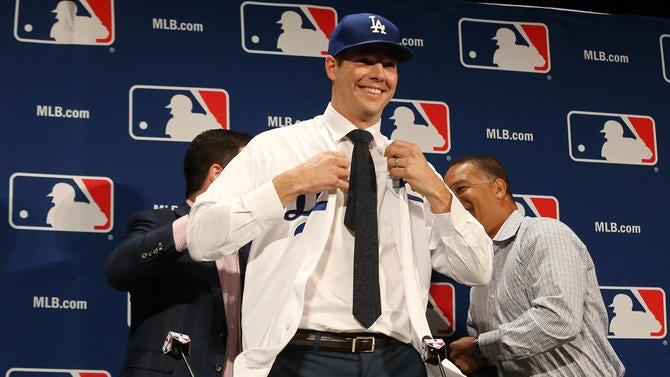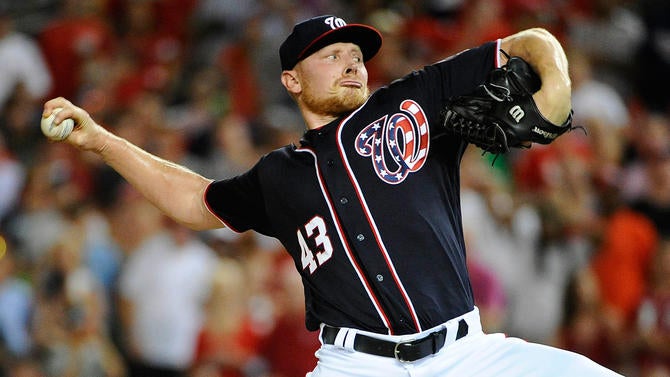Winter Meetings: Dodgers-Giants escalate NL West arms race, rivalry after Day 1 deals
Breaking down the signings of Rich Hill and Mark Melancon during the first day of the Winter Meetings

NATIONAL HARBOR, Md. -- The Los Angeles Dodgers and San Francisco Giants both made free-agent splashes Monday, escalating the NL West arms race by reeling in two of the best arms on the market.
The Dodgers brought back one of their own, inking Rich Hill to a three-year, $48 million deal. Few pitchers have taken a more circuitous route to success than Hill has over the past decade. A fourth-round pick in the 2002 draft, Hill made his major-league debut in 2005, then enjoyed his best season in 2007, whiffing 183 batters in 195 innings while flashing an ERA 15 percent better than league average. His curveball became one of the most devastating pitches in the league, a high-spin monster that he could throw for strikes in any count, anywhere in the strike zone.
Then, the injury monster attacked. From 2008 through 2014, Hill never threw more than 57 2/3 innings in a season, with season after season wiped out by setbacks ranging from Tommy John surgery to a severely strained flexor muscle, his travels taking him through six major-league teams, and eventually to the independent Atlantic League's Long Island Ducks.

On August 14, 2015, Hill signed with the Red Sox, as Boston's brass figured they would take a no-risk flyer. Working with Brian Bannister, the team's director of pitching analysis, Hill harnessed his once-dominant curve, combined with a much-improved fastball, and suddenly found his groove again: In four starts to close out the 2015 season, Hill fired 29 innings, struck out 36 batters, walked just five, allowed just 14 hits, and flashed a 1.55 ERA.
That out-of-nowhere surge earned him a one-year deal with Oakland, where he delivered a 2.12 ERA and 129 punchouts in 110 1/3 innings last season. The Dodgers nabbed him on a deadline deal, and got six excellent starts from him, including seven perfect innings on Sept. 10 against the Marlins.
That game against the Fish perfectly encapsulated what the Dodgers should expect from Hill. The 36-year-old southpaw fanned 29.4 percent of the batters he faced in 2016, the fifth-highest strikeout rate in the majors for any pitcher with as many innings pitched. But the Dodgers also keenly understand his injury history. Even though his more recent nemesis has been blisters (rather than reconstructive elbow surgery), L.A.'s brass understands that their new investment must be handled with care.
And that's perfectly OK. Last season, Hill's teammate Clayton Kershaw ably demonstrated the carnage a top pitcher can inflict on the league, tossing 149 spectacular regular-season innings, then carrying the Dodgers to within two games of the World Series. Hill won't replicate Kershaw's 1.69 ERA and Cy Young-worthy credentials, but he could still become one of the 10 best pitchers in the National League on a per-inning basis.
In a free-agent market that has quickly spiked from about $6-7 million to roughly $8 million per win above replacement, Hill contributing something like 20 healthy regular-season starts, 130-plus regular-season innings, and a fresh arm in October would be a fine get for $16 million a year. The Dodgers' approach of stockpiling eight or nine capable starters rather than shooting the moon for overpriced (non-Kershaw) aces makes getting partial seasons of greatness from the supporting even more viable.
Meanwhile, the Giants locked up closer Mark Melancon on a four-year, $62 million contract, the richest deal ever given to a relief pitcher. The Giants led the majors last season with 30 blown saves, thanks to a sharp downturn by one of the team's longest-standing strengths. The core four of Santiago Casilla, Sergio Romo, Javier Lopez and Jeremy Affeldt fell apart in 2016, thanks to a combination of age, injuries and Affeldt's retirement. San Francisco did get a smattering of decent performances from others (including rookie Derek Law), but not nearly enough to make up for the broader decline.

Melancon helps address that weakness. The 31-year-old right-hander wields terrific command, pounding the strike zone by walking just 45 batters in the past four seasons combined, while still surrendering just 10 homers in that 290-inning stretch. Melancon's excellent cutter/curveball-heavy repertoire has produced a career 56.1 percent groundball rate, and opponents' exit velocity against him consistently ranks among the lowest in the league. In short, Melancon might not be the strikeout machine that Kenley Jansen or Aroldis Chapman is, but he's still damn tough to hit.
The question here mostly comes down to asset allocation. The Melancon signing hikes the Giants' committed payroll to about $164 million ... for just 13 players. The team still has major holes to fill in left field and, unless you believe in Eduardo Nunez (you shouldn't), third base. There's a strong case to be made that the Giants would be better off signing, say, Dexter Fowler and a lower-pedigree reliever (Brad Ziegler) than Melancon and someone from the Brandon Moss phylum of cast-offs.
That said, the Giants are still a better team now than they were a day ago, and baseball's big West Coast rivalry just got a bit more interesting for next season.

















